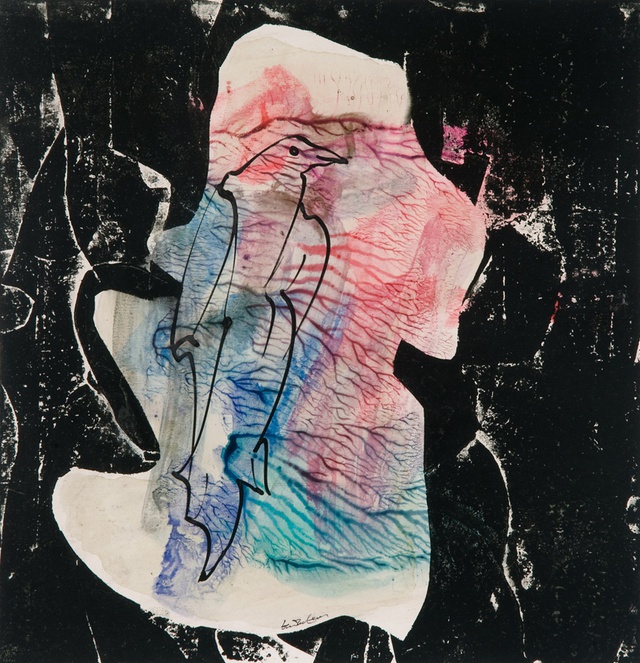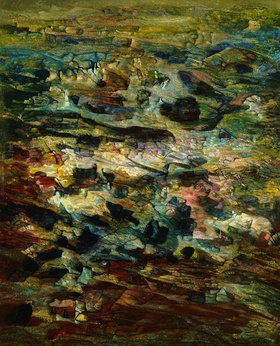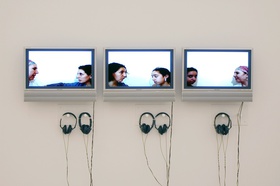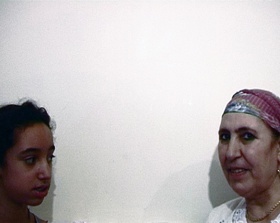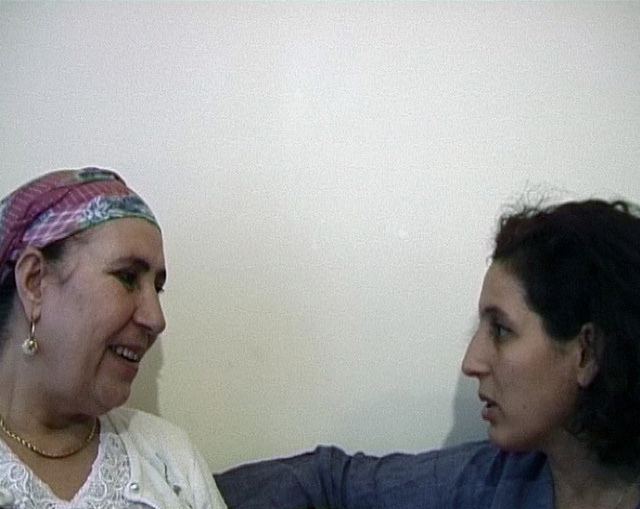Essays
Beyond the Odalisque
A Perspective on Algeria's Cultural Scene
A few months ago, a controversy erupted after I suggested in an article for Al Monitor[1] that Gulf cities are slowly replacing the traditional Arab capitals of Beirut, Baghdad, Cairo and Damascus as centres of culture in the Arab world.[2] The premise was based on the underinvestment in culture – museums and galleries in these abovementioned cities and by association the production and display of art, is diminishing, while it is expanding in the Gulf cities where museums are being built and cultural programmes developed. And while Cairo and Beirut enjoy relative stability, their access to funding is minimal. Baghdad has the funds but, along with Damascus, it is mired in civil strife.
This brings me to Algiers, a city I recently visited. Algeria's art scene, abundant with talent and a rich history of modern and contemporary art, can provide a counter-balance to the burgeoning Gulf art scene. Unlike Egypt, Lebanon, Iraq and Syria, not only is Algeria relatively stable, it is also incredibly wealthy. Algeria earned $55 billion in oil exports in 2011,[3] allowing Africa's largest natural-gas producer[4] to pay back its external debts ahead of schedule and accumulate foreign reserves that have almost reached $200 billion.[5]
Almost no other Arab government outside the UAE and Qatar has invested in art and culture as the Algerians have. For instance, the budget of the Algerian ministry of culture in 2012 was a staggering $561 million (which included an exceptional $300 million allowance).[6] The Algerian Agency for Culture Outreach was formed in 2005 to support and promote Algerian art both locally and internationally.[7] In turn, the country already boasts numerous theatres[8] and an active opera house, while a second one is being built with a $40 million grant from Chinese investors.[9]] The country also has 18 national museums, five regional museums and 24 site-specific museums, with more planned. The country also aims to open up 90 new museums by 2018[10] and is also hosting festivities to honour Constantine as the 2015 Arab Capital of Culture.[11]
Yet, at the same time, Algeria suffers from high percentages of unemployment, currently at 9.3 per cent (down from 30 per cent in 1999),[12] and has issues with corruption, which has led to protests and stirrings of civil unrest.[13] The nation also has an aging leadership and an emboldened Islamic militancy.[14] Moreover, the shadows of the bloody War of Independence with France and the Algerian Civil War of the 1990s still loom in the public consciousness.
In terms of how art addresses such issues, the reality is uneven. According to Yasmine Zidane, an Algerian expert on contemporary art, although the state cultural budget is substantial, much of it is spent to finance what she terms 'one shot international events' – yearly festivals and regional events that are held without any review of their impacts on the public or addressing a public need. However, a younger generation of Algerian artists who are thriving in the capital of Algiers, which is stable, wealthy, and is enjoying a cultural and artistic revival unlike in many other Arab capitals, are deftly tackling the issues and contradictions that are arising in Algeria's cultural scene, while also extending on a rich cultural heritage.
The extensive collection of Algeria's National Gallery of Fine Arts[15] (the website has not been updated since 2008) – founded in 1930 and occupying over 4,000 square meters[16] – is one of the greatest art museums in Africa and the Middle East that exists today. It is said that the retreating French forces wanted to take away the artworks when the 132-year occupation of Algeria ended in 1962, but the decision was finally taken to keep the works in Algiers. The collection of 8,000 oil paintings, sculptures, sketches and prints includes western and Arab masterpieces.[17] The museum's collection of Impressionist art is especially noteworthy, with artists ranging from Rodin, Manet, Monet, Gauguin, Rousseau, Courbet and Pissarro to Alfred Sisley. Here, Orientalist artworks by the likes of Delacroix, Decamps and Horace Vernet hang alongside contemporary French artworks by Pignon, Maurice Boitel and André Masson, amongst others. The museum collection also has a strong representation of works by Algerian modern masters, who include Mohammed Khadda and M'hamed Issiakhem, Ismail Samsom, Abdallah Benanteur and Abdelkader Guermaz. A number of Arab artists are also present in the collection, including Morocco's Ahmed Cherkaoui and Lebanon's Chafic Abboud and Aref El Rayess. The impressive wooden library, decked with books from ground to ceiling, is dedicated almost exclusively to pioneering Algerian female artist Baya Mahieddine, who provided inspiration for Picasso.[18]
I toured the museum with young Algerian artist Sofiane Zouggar,[19] who forms part of the Box 24 young independent artists collective formed over the past few years producing works that are reflective of the changes and issues in Algerian society with a globalized outlook.[20] Zouggar, along with his Box 24 peers, grew up in the shadows of the Algeria's 'Dirty War' of the 1990s. That decade represented a major shift in the Algerian psyche. 40 years after the War of Independence against foreign occupiers, Algeria was waging an internal war amongst its own, resulting in the deaths of 150,000 and the disappearance of another 7,000.[21] Following his election in 1999, the current president Abdelaziz Bouteflika passed a law guaranteeing amnesty to those who handed in their weapons and launched the Ad Hoc Inquiry Commission in Charge of the Question of Disappearances, which was charged with addressing the fate of the victims of the Dirty War of the 1990s.[22]
The topic of the 'Dirty War' has naturally been a difficult subject to tackle in popular culture, and its end ushered in an era of self-censorship, but this is starting to change. One artist told me that, prior to the war, the portrayal of nudity in art was still acceptable. On our tour of the National Gallery, Zouggar showed me paintings by French Orientalist artist Nasreddine Dinet, who converted to Islam while living in Algiers, and whose early twentieth century work contained, despite being known as relatively conservative, much nudity. 'I used to paint replicas of this artwork when I was in university to raise money for my education,' Zouggar said. For his next project, however, the young multidisciplinary artist will tackle the theme of the 1990s – a decade of terror in Algeria from which the country is now emerging – directly.
In the past few years, Algeria's art scene has been witnessing a sort of revival. The country's Museum of Modern Art was inaugurated in 2007,[23] the year Algiers became the Capital of Arab Culture, as appointed by UNESCO.[24] The building, located in central Algiers, previously served as a shopping mall and today hosts rotating exhibitions of modern and contemporary Algerian and international artists. The museum, which last year received 100,000 visitors,[25] opened with a dedicated show about the quintessential Middle Eastern story of Majnun Layla, a story of unrequited love, by Algerian artist Malek Salah.[26] Subsequent exhibitions include retrospectives of accomplished Algerian artists such as Mohamed Khadda and M'hamed Issiakhem,[27] as well as a symposium on late Palestinian poet Mahmoud Darwish.[28] In 2014, the museum will host an exhibition dedicated to the female freedom fighters of the Algerian war of independence.[29] The MAMA, as the museum is known, also hosts the International Festival of Contemporary Art of Algiers (FIAC),[30] which, unlike some art fairs across the Arab world, doesn't shun themes such as resistance, war and the Israeli occupation of Arab lands.[31] Yasmine Zidane credits the MAMA for exhibiting Algerian artists who had achieved fame abroad but not necessarily in Algiers such as Mahdjoub Ben Bella[32] and Djamel Tatah.[33]
Algeria also has a number of fine arts colleges in cities including Mostaganem, Oran, Constantine and the oldest school of fine arts in Algiers, which was founded as far back as in 1881.[34] Today, a number of contemporary artists of Algerian origin or nationality, many of whom have graduated from these colleges, are having an impact on the contemporary Arab and international art scenes. Zineb Sedira,[35] whose work has been shown in New York, Singapore and Sharjah, established an arts residency program in Algiers in 2011.[36] Berlin-based artist Kader Attia, whose work was shown at the Barjeel Art Foundation in 2011 in Sharjah, tackles themes such 'the complex relationship between East and West and how this has played out in Europe and its immigrant communities'.[37] Adel Abdessemed's infamous statue of legendary Algerian footballer Zenidine Zidane head-butting another player during the 2006 World Cup briefly went on display on Doha's corniche before being removed following online complaints from the native population of Qatar, who saw it as offensive to religious sensitivities.[38]
Of course, the contemporary art scene in Algiers faces a slew of challenges,[39] including a dearth of funding for independent artists not affiliated with government institutions (the Algerian artist Zouggar told me he was now applying for funding from the Beirut-based Arab Fund for Arts and Culture)[40] as well as administrative and government restrictions. Algeria, like most Arab states save perhaps for Lebanon, enacts strict censorship laws. Following a caricature in which he likened President Bouteflika's plans to run for a fourth term to baby diapers, cartoonist Djamel Ghanem is now facing 18 months in jail for the crime of mocking the president.[41] The cartoonist has also faced difficulty with employment, noting that newspaper editors were advised not to hire him, thereby reinforcing self-censorship amongst artists and other cultural commentators.
Moreover, with few exceptions, the Algerian art scene still largely relies on France as its conduit to the outside world; although France today is no longer the major player it once was in the arts world.[42] For example, France's notorious bureaucracy prompted one major collector to move his entire collection to Italy.[43] Nor is French today the lingua franca of art, since the art world's major publications are published predominantly in English. As such, Algerian artists and websites need to incorporate the use of English in order for their works to be easily accessible to non-French speakers. One artwork that perhaps reflects the language barrier between art in Algiers and the outside world is a video installation by Zineb Sedira, Mother Tongue (2002),[44] which was shown at the Singapore Art Museum last year as part of Terms And Conditions, Barjeel Art Foundation's first international exhibition.[45] In the video, the artist's mother, who spoke Arabic, is unable to communicate with her granddaughter, who spoke English. To a degree, Algeria's art scene resembles Sedira's Mother Tongue – in the country, there is a young generation of artists in tune with the world, yet who are unable to communicate with an older generation due to linguistic, political and historic restrictions.
Unlike in the Gulf, which was under the British 'protectorate system',[46] France's 132-year military conquest and occupation of Algeria was coupled with a ruthless policy of 'Francization'[47] that sought to erase the cultural identity of Algerians. Yet, today, more than 50 years after independence, Algeria is a country bursting with young talent, history and a unique culture that survived and even flourished despite the French occupation, the War of Independence and the Dirty War of the 90s, the last of which was followed by a reconciliation process that was described as a 'pact of silence'.[48]
Of course, Algeria isn't only distinguished by its arts scene – the country is a rich mix of Arab, Mediterranean, Berber and African cultures, which has inspired generations of literary figures and poets. The country's Raï music genre is now recognized not only in the region but also around the world. Writers such as Kateb Yacine, Assia Djebar, Malek Bennabi and Ahlam Mosteghanemi, amongst many others, have had their books translated into numerous languages and are popular across the Arab world.[49] In thinking about the country's rich cultural legacy, and what is happening today, art in Algeria has the potential to provide an essential conduit for the public discussion on matters that relate directly to the country's past, present and coming future. If this is the case, life could indeed imitate art.
[1] Sultan Soouad Al Qassemi, 'Thriving Gulf Cities Emerge as New Centers of Arab World', Al Monitor, 8 October 2013 http://www.al-monitor.com/pulse/originals/2013/10/abu-dhabi-dubai-doha-arab-centers.html##ixzz2vZI3n4dh'.
[2] 'Responses to Gulf Cities as new Arab Centres of Culture & Commerce article', Felix Arabia, blog post, 15 October 2013 http://sultanalqassemi.blogspot.ae/2013/10/responses-to-gulf-cities-as-new-arab.html.
[3] 'Not so jolly: Algeria's Oil and Gas', The Economist, 9 February 2013 http://www.economist.com/news/middle-east-and-africa/21571480-recent-events-and-wariness-foreign-investors-dent-oil-and-gas-economy-not.
[4] 'Algeria', U.S. Energy Information Administration website, 20 May 2013 http://www.eia.gov/countries/cab.cfm?fips=ag.
[5] 'Algeria's $200bn foreign currency reserves', BBC New Africa, 15 May 2012 http://www.bbc.co.uk/news/world-africa-18073734.
[6] 'En baise de 50% par rapport à 2012', Le Blog de l'Action Culturelle Algerienne, blog entry, 4 January 2013 http://www.alger-culture.com/news.php?readmore=75.
[8] Mehdi Isikioune, '«L'Algérie compte réaliser 90 établissements muséaux à l'horizon 2018»', La Nouvelle Republique http://www.lnr-dz.com/index.php?page=details&id=21305.
[9] Souad Tlemcani, 'China hopes to hit the right note with Algeria opera house', The Guardian, 29 April 2013 http://www.theguardian.com/global-development/2013/apr/29/china-algeria-opera-house.
[10] Isikioune, op cit.
[11] See: 'Algeria: Constantine to be 2015 world Arab culture capital', ANSA Med website, 28 February 2013 http://www.ansa.it/ansamed/en/news/nations/algeria/2013/02/28/Algeria-Constantine-be-2015-world-Arab-culture-capital_8324646.html.
[12] 'Algerian unemployment to drop to 9.3% in 2013, says IMF', ANSA Med website, 15 April 2013 http://ansamed.ansa.it/ansamed/en/news/nations/algeria/2013/04/15/Algerian-unemployment-drop-9-3-2013-says-IMF_8555319.html.
[13] 'Thousands protest unemployment in Algeria', Al Jazeera website, 14 March 2013 http://www.aljazeera.com/news/africa/2013/03/201331415371252748.html.
[14] 'Algeria, corruption and Islamic militancy', London School of Economics Blog, blog entry, 20 November 2013 http://blogs.lse.ac.uk/africaatlse/2013/11/20/algeria-corruption-and-islamic-militancy/.
[16] 'Historique Du Musee National Des Beaux Arts', Le Musee National Des Beaux Arts website, 2008 http://www.musee-beauxarts.dz/historiquefr.html.
[18] Sana` Makhoul, 'Baya Mahieddine: An Arab Woman Artist', Contemporary Algeria, blog entry, 23 September 2007 http://djamelmoktefi.blogspot.co.uk/2007/09/baya.html.
[20] For more information see: 'Box 24 Profil', Weone Art Website http://www.galerie-com.com/profil/8620/; and Angelika Stepken, 'We try to communicate with other people', Villa Romana website http://www.villaromana.org/front_content.php?&idcat=99&changelang=2&idart=541.
[21] 'Background: No Redress for Victims', International Center for Transitional Justice (ICTJ) website https://ictj.org/our-work/regions-and-countries/algeria.
[22] 'Commission of Inquiry: Algeria', United States Institute for Peace website, 21 September 2003 http://www.usip.org/publications/commission-of-inquiry-algeria.
[23] See: http://www.mama-dz.com/.
[24] Boualam Senhadji, 'Algiers as 2007 Arab Cultural Capital receives mixed reviews', Magharebia, 11 January 2008 http://magharebia.com/en_GB/articles/awi/reportage/2008/01/11/reportage-01.
[25] John Thorne, 'Exhibit A', Brownbook website, 8 September 2012 http://brownbook.me/exhibit-a/.
[26]] 'Majnun Layla', Musee Public National d'Art Moderne and Contemporain website, 2007 http://www.mama-dz.com/art-algerie/expositionsDetails/14.
[27] For more information see artist's website: http://www.missiakhem.net/FONDATION/portail/portail.php.
[29] 'Programme', Musee Public National d'Art Moderne and Contemporain website, 2014 http://www.mama-dz.com/art-algerie/expositionsDetails/49.
[30] 'The 3rd International Festival of Contemporary Art of Algiers (FIAC), 2011', Nafas Art Magazine, December 2011 http://universes-in-universe.org/eng/nafas/articles/2011/fiac_algiers.
[31] Kaelen Wilson-Goldie, 'FIAC exhibition uses art to open public discourse in Algiers', The Daily Star: Lebanon News, 16 December 2011 http://www.dailystar.com.lb/Culture/Art/2011/Dec-16/156997-fiac-exhibition-uses-art-to-open-public-discourse-in-algiers.ashx#ixzz2van8BII7.
[32] Mohammed Djehiche et al., Mahjoub Ben Bella, exhibition catalogue (Algiers: Imprimerie Ed-Diwan, 2012).
[33] Éric de Chassey, ed., Djamel Tatah, exhibition catalogue (Algiers: ColorSet, 2013).
[34] Michèle Salerio, 'La Societe Des Beaux-Arts D'Alger Ou Quand Les Muses S'Amusaient', Es'maa, blog entry, June 2008 http://esmma.free.fr/mde4/bxarts4.htm.
[35] 'Zineb Sedira', Universes in Universe website, 2003 http://universes-in-universe.de/car/sharjah/2003/art/sedira/english.htm.
[36] 'Who We Are', ARIA website, http://ariaprojects.org/?page_id=5.
[37] 'Kader Attia', Barjeel Art Foundation website http://www.barjeelartfoundation.org/artist/algeria/kader-attia/.
[38] For more information, see: 'Qatar removes Zidane statue after outcry', Al Jazeera website, 31 October 2013 http://www.aljazeera.com/news/middleeast/2013/10/qatar-removes-zidane-statue-after-outcry-201310302338612974.html; Robert Mackey, 'Qatar Removes Statue of Zidane's Head Butt After Complaints', The New York Times, blog entry, 30 October 2013 http://thelede.blogs.nytimes.com/2013/10/30/qatar-removes-statue-of-zidanes-head-butt-after-complaints/?_php=true&_type=blogs&_php=true&_type=blogs&_r=1; and Victoria Scott, 'QMA moves Zidane head-butt statue from Corniche to Mathaf', Doha News, 28 October 2013 http://dohanews.co/qma-moves-zidane-head-butt-statue-from-corniche-to-mathaf/.
[39] Alice Planel, 'Productive Contexts and Contemporary Restraints: The Practice of Contemporary Art in Algeria Today', Ibraaz, 2 May 2012 http://www.ibraaz.org/essays/35.
[40] See: http://www.arabculturefund.org/home/index.php.
[41] Abdou Semmar, 'Algerian Cartoonist Faces 18 Months in Jail for Mocking President', Global Voices website, 17 February 2014 http://globalvoicesonline.org/2014/02/17/algerian-cartoonist-faces-18-months-in-jail-for-mocking-president/.
[43] Laurie Attias, 'Delays Prompt France's Pinault To Ponder a Museum in Italy', ARTnews, 26 April 2005 http://www.artnews.com/2005/04/26/delays-prompt-frances-pinault-to-ponder-a-museum-in-italy/.
[45] See: Anna Seaman, 'Power trip: Barjeel Art Foundation goes to Singapore', The National website, 24 June 2013
http://www.thenational.ae/arts-culture/art/power-trip-barjeel-art-foundation-goes-to-singapore#ixzz2vaza5aqX; and Susan Kendzulak, '"Terms and Conditions" apply: Arab art in Singapore', Art Radar Asia, 7 July 2013 http://artradarjournal.com/2013/07/07/terms-and-conditions-apply-arab-art-in-singapore/.
[46] Suzi Mirgani, 'James Onley on Britain's Local Representatives in the Gulf', Georgetown University Centre for International and Regional Studies website, 2009 http://cirs.georgetown.edu/105287.html.
[47] 'Algeria: From Colonial Cultural Policy to Hegemonic Cultural Policy', Algeria Solidarity Campaign website http://www.algeriasolidaritycampaign.com/algeria-from-colonial-cultural-policy-to-hegemonic-cultural-policy-part-of-algeria-cultural-festival-london-october-20th/.
[48] Martin Evans and Joanne J. Myers, 'Algeria: Anger of the Dispossessed', Carnegie Council for Ethics in International Affairs, 14 February 2014 http://www.carnegiecouncil.org/studio/multimedia/20080214/index.html.
[49] Patrick Ball, 'Towards a Literature of Independence: The Best Algerian Writers', The Culture Trip http://theculturetrip.com/africa/algeria/articles/towards-a-literature-of-independence-the-best-algerian-writers/%0A.

